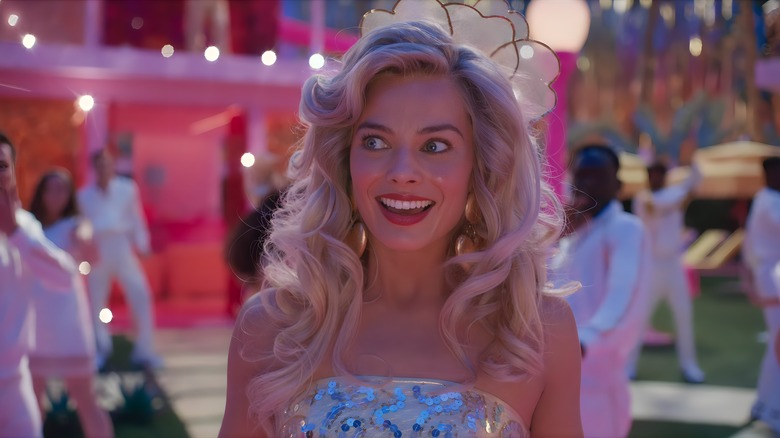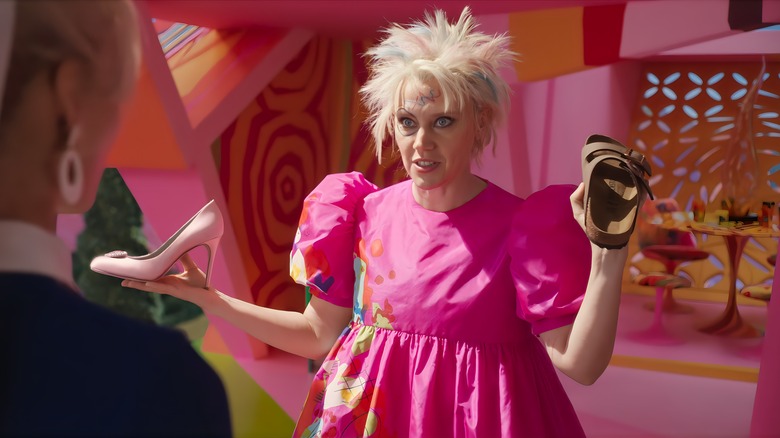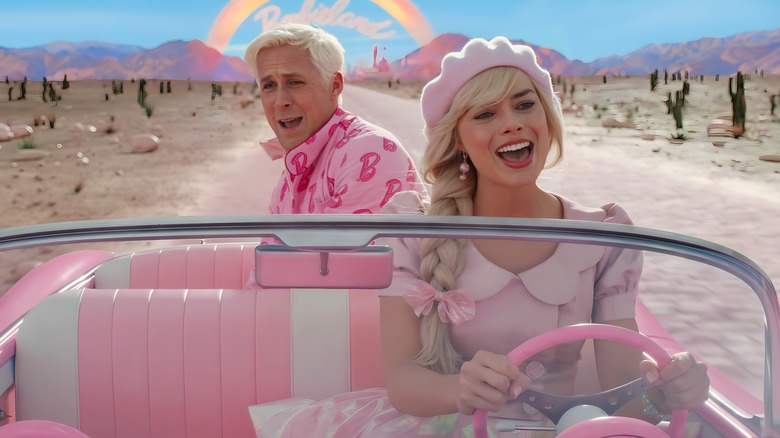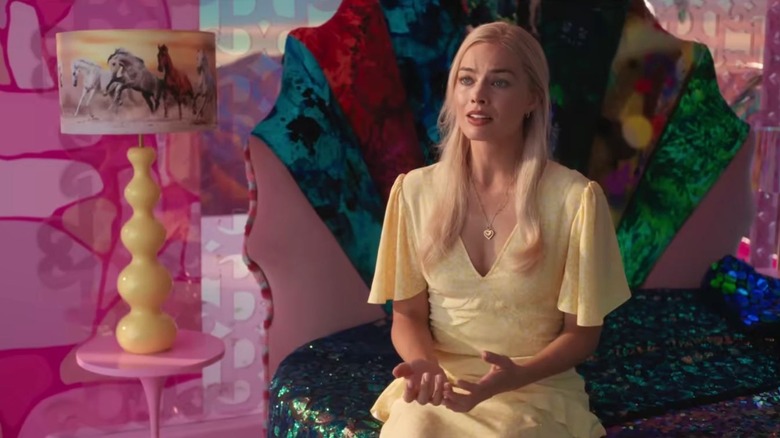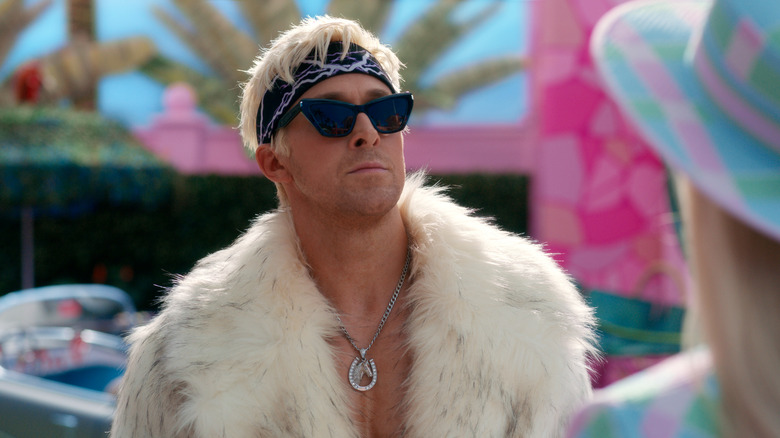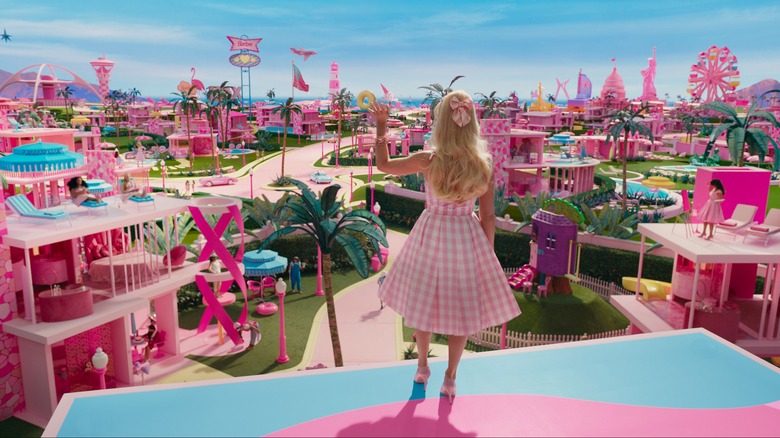Barbie: The Small Details Fans Only Notice On A Rewatch
Greta Gerwig's third solo directorial debut is her biggest and most ambitious film yet, and that effort has paid off handsomely. "Barbie" is one of the biggest cultural phenomenons in recent memory, breaking records at the box office as the weeks continue to pass since its July 21 release. Gerwig is now the first female director to helm a movie that earned over a billion dollars at the box office, and star and executive producer Margot Robbie established herself as a blockbuster producer — and took home a handsome bonus to boot. The finances aside, "Barbie" is critically acclaimed, already scoring Oscar buzz for everything from its central performances to its stunning design, and just a genuinely good movie that'll make you laugh and cry in equal measure.
"Barbie" is so good that it actually deserves repeat viewings, and thanks to Gerwig's attention to detail — and that of her entire creative team — there's a lot you might notice during your second, third, or fourth trip to the theater. From curious keychains to deliberate typos to Hollywood references, here's what you might have missed during your first viewing of "Barbie."
Weird Barbie has an... interesting keychain
When Stereotypical Barbie (Robbie) starts experiencing strange symptoms of ennui like cellulite, irrepressible thoughts of death, and flat feet, she's told to go up the hill in Barbie Land and visit Weird Barbie, played by "Saturday Night Live" alum Kate McKinnon. Weird Barbie, who got played with "too hard" by her owner, is doomed to a life of strangeness while she helps make the other Barbies perfect and more beautiful, and McKinnon hits every single strange note — but her makeup and costuming is really the highlight.
Weird Barbie is, in her own words, "always in the splits and smells like basement," and after she's seen in a bizarre babydoll dress earlier in the movie, she's dressed for war later on in the narrative with combat boots, spiky hair, and sparkly shoulder pads. That's not all, though. If you pay close attention to Weird Barbie's war outfit, she's got a keychain adorned with a ton of loose Barbie legs, which one can only presume were removed from real-life Barbies by customer designer Jacqueline Durran. What purpose these disembodied Barbie legs served for Weird Barbie is unknown, but she really is as wise as she is weird, so she's probably got grand plans for them if they're not already coming in handy.
Barbie is chock-full of references to The Wizard of Oz
Gerwig has been extremely open about her influences and references for "Barbie;" she even spoke to Letterboxd about it, listing the films that played a part in her process. Alongside classics like "The Red Shoes" and "Singin' in the Rain," Gerwig invoked "The Wizard of Oz," which is definitely clearly referenced in the movie a number of times (beyond the fact that both movies are about a girl transported to a new world entirely different from her own). As Barbie drives around town greeting all her Barbie friends at the movie's start, she passes Barbie Land's movie theater, and what's on the marquee? "The Wizard of Oz," of course.
"The Wizard of Oz, obviously is an extraordinary movie and beautiful and beloved," Gerwig told Letterboxd in an interview that ran alongside her official watchlist. "It does something that I wanted to emulate, which is these incredible sound stages and these painted skies and this sense of... I say, 'authentically artificial,' which I think is very beautiful and emotional. I think of the painted backdrop of the Emerald City as they go towards it. In our movie, we have the Pink Brick Road instead of the Yellow Brick Road. We also have beautiful painted backdrops of horizons."
Stereotypical Barbie's hair has its own journey
When Barbie goes to the Real World and realizes that Barbie Land hasn't actually created equality for all women, it only deepens her existential crisis — which is reflected in her hair. In a clever move, her hair, which is enormous and larger-than-life when the film begins, subtly shrinks throughout; by the time Barbie realizes what she needs to do, her hair looks less like a doll's and more like a real person's. Where Barbie once had a thick mane of hair that produced an enormous braid — highly reminiscent of exactly how the doll's hair looks in a braid — she now has realistic hair that matches her mental journey.
Makeup and hair designer Ivana Primorac told Allure that this was entirely intentional: "The hair deflates and becomes a more normal amount of hair. She suddenly has hair that's normal length, and the amount of hair goes back to human [levels]. That happens quite slowly. By the end when she goes into the doctor's office, she has a completely normal amount of hair." This is a reference to the very end of the film, where Barbie, after choosing to become a human woman, heads to see her gynecologist for the very first time, proudly bearing the name "Barbara Handler" (an homage to the real daughter of Barbie creator Ruth Handler).
Ken doesn't know how to spell
Barbie — and her hair — go on an intense journey throughout the film, but Ken (Ryan Gosling) receives an emotional arc of his own. After joining Barbie on her journey to the real world, Ken makes a startling discovery; unlike the matriarchy that is Barbie Land, the real world lets men be in charge, and Ken is very into this idea. He transports a pretty clunky, half-baked version of patriarchy back to Barbie Land, and though it's mostly centered around horses, fur coats, and "brewski beers," and in Barbie's absence, he steals her house and turns it into his very own "Mojo Dojo Casa House."
Maybe one of the funniest details in Ken's Mojo Dojo Casa House, though, is a tiny little detail on his Western-style doors. If you look closely, you'll notice that the logo on the doors says "KENDOM SALON" in all caps, not "saloon" like it probably should... but someone (Ken) has added an extra "O" to make sure it's correct. It feels absolutely impossible that the design team made a misspelled sign and didn't fix it, so this is definitely an indication that Ken just can't spell and made a hasty adjustment.
Barbie Land changes for the better
When the movie starts, Barbie Land is a full-fledged matriarchy. The President (Issa Rae) is a woman, every member of the Supreme Court is a woman, and as Barbie later tells Gloria (America Ferrera) and Sasha (Ariana Greenblatt), everything that men do in the real world, women do in theirs. This might seem like a utopia for any feminine person, but the real gist of this movie is that one party's supremacy hurts everybody. When Sasha asks Barbie where the Kens live, she genuinely doesn't know — and when her dream house becomes the Mojo Dojo Casa House, she's left bereft.
Barbie ultimately helps Ken realize that he needs to discover who he is without her and that he is, in fact, "kenough" — and in the process, the Barbies restore Barbie Land to its former glory. Well, kind of. When the Mattel CEO says everything can go back to normal, President Barbie corrects him and says that, actually, that's not what they want, and that the Kens should be able to learn from the Barbies and work their way into positions that hold even a modicum of power. If you pay attention, you'll see that the Barbie dream houses still have some horses, salo(o)n doors, and big cars laying around, making it clear that the Barbies are making room for the Kens this time around.
